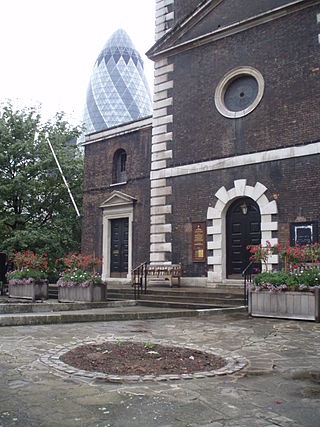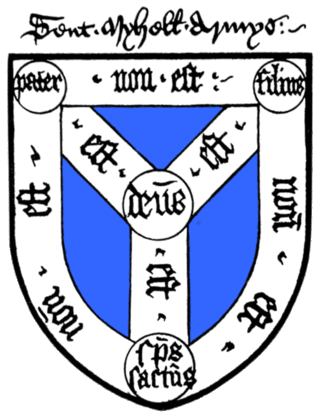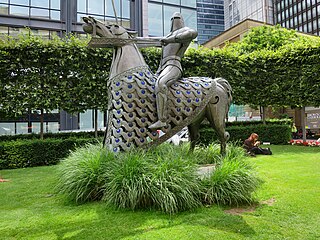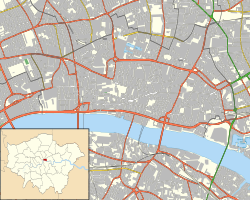
Aldgate was a gate in the former defensive wall around the City of London.

Bishopsgate was one of the eastern gates in London's former defensive wall. The gate's name is traditionally attributed to Earconwald, who was Bishop of London in the 7th century. It was first built in Roman times and marked the beginning of Ermine Street, the ancient road running from London to York (Eboracum). The gate was rebuilt twice in the 15th and 18th centuries, but was permanently demolished in 1760.

Minories is the name of a small former administrative unit, and also of a street in the Aldgate area of the City of London. Both the street and the former administrative area take their name from the Abbey of the Minoresses of St. Clare without Aldgate.

Botolph of Thorney was an English abbot and saint. He is regarded as the patron saint of boundaries, and by extension, of trade and travel, as well as various aspects of farming. His feast day is celebrated either on 17 June (England) or 25 June (Scotland).

Houndsditch is a street running through parts of the Portsoken and Bishopsgate Without wards of the City of London; areas which are also a part of the East End of London. The road follows the line of the outside edge of the ditch which once ran outside the London Wall. The road took its name from the section of ditch between Bishopsgate and Aldgate. The name may derive from the widespread dumping of rubbish in this stretch of ditch; relating to the dumping of dead dogs, or the scavenging of the waste by feral dogs.
Minories is a street in Central London and former civil parish also known as Holy Trinity Minories

St. Botolph's Priory was a medieval house of Augustinian canons in Colchester, Essex, founded c. 1093. The priory had the distinction of being the first and leading Augustinian convent in England until its dissolution in 1536.

St George Botolph Lane was a church off Eastcheap, in the ward of Billingsgate in the City of London. The rear of the church overlooked Pudding Lane, where the fire of London started. It was first recorded in the twelfth century, and destroyed in the Great Fire of 1666. It was one of the 51 churches rebuilt by the office of Sir Christopher Wren. The church was demolished in 1904.

St Botolph-without-Bishopsgate is a Church of England church in the Bishopsgate Without area of the City of London, and also, by virtue of lying outside the city's eastern walls, part of London's East End.

St Botolph without Aldersgate is a Church of England church in London dedicated to St Botolph. It was built just outside Aldersgate, one of the gates on London's wall, in the City of London.

The Worshipful Company of Parish Clerks is one of the Guilds of the City of London. It has no livery, because "in the 16th century, the Parish Clerks declined to take the Livery on the grounds that the surplice was older than the Livery and was the proper garb of members of the Company." It is not, therefore, technically a livery company although to all intents and purposes it acts as such. It is one of two such historic companies without livery, the other being the Company of Watermen and Lightermen.

Portsoken, traditionally referred to with the definite article as the Portsoken, is one of the City of London, England's 25 ancient wards, which are still used for local elections. Historically an extra-mural ward, lying east of the former London Wall, the area is sometimes considered to be part of the East End of London.

The Holy Trinity Priory, also known as Christchurch Aldgate, was a priory of Austin canons founded around 1108 by the English queen Matilda of Scotland near Aldgate in London.

St Botolph's, Billingsgate was a Church of England parish church in London. Of medieval origin, it was located in the Billingsgate ward of the City of London and destroyed by the Great Fire of London in 1666.

East Smithfield is a small locality in the London Borough of Tower Hamlets, east London, and also a short street, a part of the A1203 road. Once broader in scope, the name came to apply to the part of the ancient parish of St Botolph without Aldgate that was outside of the City of London.

The Knighten Guilde or Cnichtengild, which translates into modern English as the Knight's Guild, was an obscure Medieval guild of the City of London. According to A Survey of London by John Stow (1603), it was in origin an order of chivalry founded by the Saxon king Edgar for loyal knights.

Holy Trinity, Minories, was a Church of England parish church outside the eastern boundaries of the City of London, but within the Liberties of the Tower of London and therefore in the East End of London. The liberty was incorporated in the Metropolitan Borough of Stepney in 1899, and today is within the City of London. Converted from the chapel of a nunnery, Holy Trinity was in use as a church from the 16th century until the end of the 19th century. It survived as a parish hall until it was destroyed by bombing during World War II.

St Botolph without Aldgate was an ancient parish immediately east of and outside (without) Aldgate, a gate in London's defensive wall. The parish church was St Botolph's Aldgate.

St Osyth's Abbey was a house of Augustine Canons Regular in the parish of St Osyth in Essex, England in use from the 12th to 16th centuries. Founded by Richard de Belmeis, Bishop of London, c. 1121, it became one of the largest religious houses in Essex. It was dedicated to Saints Peter and Paul as well as St Osyth (Osith), a royal saint and virgin martyr. Bishop Richard obtained the arm bone of St Osyth from Aylesbury for the monastic church and granted the canons the parish church of St Osyth.





















